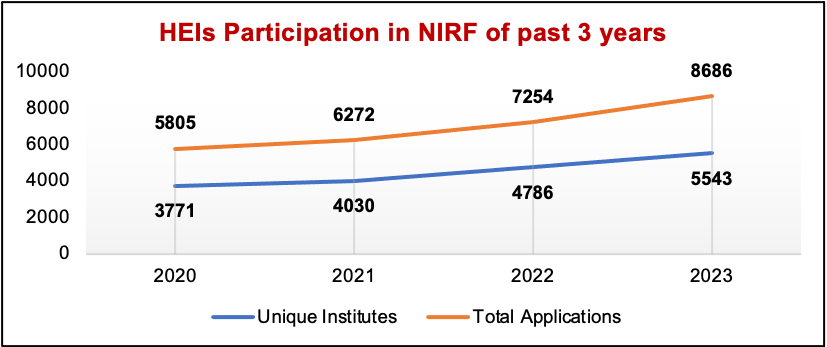National Institute Ranking Framework (NIRF)
1. Session Brief
NEP, 2020 recognises India’s aim to have an education system by 2040 that is second to none, with access to the highest quality education for all learners regardless of social or economic background. India will be promoted as a global study destination providing premium education at affordable costs.
The National Institutional Ranking Framework (NIRF) was introduced in 2016 to evaluate the performance of higher education institutions in India. The NIRF reports have played a significant role in improving the education ecosystem as different stakeholders involved in higher education, view institutional rankings as a gauge of quality. HEIs use them as a crucial performance yardstick to evaluate their own performance and compare it to that of their peers. Also, the publicly available NIRF report helps students choose the best university. NIRF has also played a pivotal role in ensuring that universities continue to put in great effort to ensure that they are offering academic education on pace with global norms. It also fulfils the need of a common parameter to assess all the HEIs in the country.
In the 1st National Conference of the Chief Secretaries in June 2022, one of the decisions was to study methodology for ranking of HEIs and ranking parameters, based on which an appropriate roadmap be drawn to improve ranking of Indian HEIs subject and university wise both nationally and globally. Also, in the 7th Governing Council meeting of NITI Aayog, it was emphasised, inter-alia, that NIRF should be made mandatory for all universities.
With the advent of NEP 2020 and increasing focus on ranking and internationalization, the eighth edition of NIRF was published on June 5, 2023, with significantly improved HEIs participation. The government released the Guidelines for Transforming Higher Education Institutions, impact of which has directly fed into better performance of HEIs in NIRF.To be ranked, all education institutions are assessed on five parameters: teaching, learning and resources, research and professional practices, graduation outcomes, outreach and inclusivity, and perception. Under NIRF 2023, a total of 13 category rankings were published. A new ranking framework was created for the recently announced Agriculture and Allied sector rankings.

There has been tremendous growth in the participation of HEIs in NIRF in the past three years as seen in the graph. The year-on-year increase in institutions and applications demonstrate how more stakeholders in higher education are becoming aware and participating in the NIRF ranking.
With NEP 2020 promoting higher quality of education and adherence to global standards, the NIRF rankings have helped elevate Indian HEIs into international rankings as well. About 45 HEIs/Universities were ranked in QS 2024, with 11 placed in top 500. 44 courses, in their respective subject categories, have been ranked among the Global top 100 in QS Rankings 2023.
11.1 Expected Outcomes of the Session
- Understanding the importance of NIRF framework and process of participation.
- Deliberation on the methodology adopted for the ranking nationally and globally; and develop appropriate roadmap for improved ranking.
- Scope of developing State/UT specific Institutional Ranking Frameworks to develop regional HEIs.
- Pathways to improve performance of various parameters of NIRF by targeted development of different aspects of HEIs.
11.1 Roadmap for the Institutes
- Increasing awareness and support
- Workshops - More institutions may be encouraged to participate in NIRF rankings under various categories by raising awareness on the benefits of NIRF assessment. Workshops may be conducted for institutions about the process of application to NIRF, relevant timelines, methodology etc. to orient them with key requirements for participation.
- Mentor-mentee model - Top ranked NIRF institutions may be encouraged by States/UTs to mentor other HEIs through hub-and-spokes model on how to improve their facilities and quality education.
- Targeted improvements by HEIs
- Focus on lagging parameters - Institutions may be encouraged to form their Internal Quality Assurance Cell (IQAC) to improve ranking through targeted focus on quality benchmarking and development that HEIs presently lag in.
- Identification by experts – Industry experts and leaders may be involved in the Board of Directors /Governors who may then identify & guide on suitable areas of improvement in the institution, such as how to capitalize on industry connect to improve research quality, citation score, etc.
- Linkage to international standards - Institutions participating in NIRF may be further encouraged to participate in international rankings such as THE, QS, etc for improved adherence to global standards of education.
- Improvements in data
- Tracking YoY trends - A consolidated database may be maintained for NIRF for tracking year-on-year data and trends in rankings.
- Consolidated database – A consolidated database may be prepared based on data collected during NIRF, that may be linked to data collected during AISHE, NAAC, etc.
Name of Panelist
| National Institutional Ranking Framework (NIRF) | Chair | Prof. Anil Sahasrabudhe, Chairman, NETF |
| Panellist | Prof. K. Radhakrishnan, Chairman, Standing Committee of IIT Council | |
| Panellist | Dr. Ram Sharma, VC, UPES | |
| Panellist | Dr. Bhimaraya Metri, Director, IIM, Nagpur | |
| Panellist | Prof. K. Umamaheshwar Rao, Director, NIT Rourkela |
Relevant Documents
- Final Report - (107 KB)
- Transformative Reforms on the Anvil - for Strengthening Periodic Assessment, Accreditation, and Ranking of India’s Higher Educational Institutions - (249 KB)
- National Institute Ranking Framework (NIRF) - (1.50 MB)


